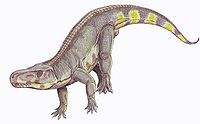
Crurotarsi is a clade of archosauriform reptiles that includes crocodilians and stem-crocodilians and possibly bird-line archosaurs too if the extinct, crocodile-like phytosaurs are more distantly related to crocodiles than traditionally thought. Prior to 2011, the group had invariably included only archosaurs closer to crocodilians than to birds and other dinosaurs. An equivalent term for the crocodilian side of the archosaur family tree is Pseudosuchia. This traditional definition of Crurotarsi assumed that phytosaurs were crown-group archosaurs and more closely related to crocodilians than to birds. However, a 2011 study argued that the phytosaur lineage evolved prior to the split between birds and crocodilians. This would mean that phytosaurs were not true archosaurs, and therefore could not be considered representatives of croc-line archosaurs.

"Rauisuchia" is a paraphyletic group of mostly large and carnivorous Triassic archosaurs. Rauisuchians are a category of archosaurs within a larger group called Pseudosuchia, which encompasses all archosaurs more closely related to crocodilians than to birds and other dinosaurs. First named in the 1940s, Rauisuchia was a name exclusive to Triassic archosaurs which were generally large, carnivorous, and quadrupedal with a pillar-erect hip posture, though exceptions exist for all of these traits. Rauisuchians, as a traditional taxonomic group, were considered distinct from other Triassic archosaur groups such as early dinosaurs, phytosaurs, aetosaurs, and crocodylomorphs.

Poposauridae is a family of large carnivorous archosaurs which lived alongside dinosaurs during the Late Triassic. They were around 2.5 to 5 metres long. Poposaurids are known from fossil remains from North and South America. While originally believed to be theropod dinosaurs, cladistic analysis has shown them to be more closely related to crocodiles.

Gracilisuchus is an extinct genus of tiny pseudosuchian from the Late Triassic of Argentina. It contains a single species, G. stipanicicorum, which is placed in the clade Suchia, close to the ancestry of crocodylomorphs. Both the genus and the species were first described by Alfred Romer in 1972.

Pseudosuchia is one of two major divisions of Archosauria, including living crocodilians and all archosaurs more closely related to crocodilians than to birds. Pseudosuchians are also informally known as "crocodilian-line archosaurs". Despite Pseudosuchia meaning "false crocodiles", the name is a misnomer as true crocodilians are now defined as a subset of the group.

Ticinosuchus is an extinct genus of suchian archosaur from the Middle Triassic of Switzerland and Italy.

Batrachotomus is a genus of prehistoric archosaur. Fossils of this animal have been found in southern Germany and dated from the Ladinian stage of the Middle Triassic period, around 242 to 237 million years ago. Batrachotomus was described by palaeontologist David J. Gower 22 years after its discovery.
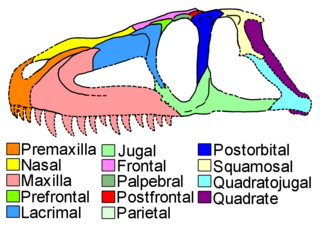
Luperosuchus is an extinct genus of loricatan pseudosuchian reptile which contains only a single species, Luperosuchus fractus. It is known from the Chañares Formation of Argentina, within strata belonging to the latest Ladinian stage of the late Middle Triassic, or the earliest Carnian of the Late Triassic. Luperosuchus was one of the largest carnivores of the Chañares Formation, although its remains are fragmentary and primarily represented by a skull with similarities to Prestosuchus and Saurosuchus.
Yarasuchus is an extinct genus of avemetatarsalian archosaur that lived during the Anisian stage of the Middle Triassic of India. The genus was named and described in 2005 from a collection of disarticulated but fairly complete fossil material found from the Middle Triassic Yerrapalli Formation. The material is thought to be from two individuals, possibly three, with one being much more complete and articulated than the other. The type and only species is Y. deccanensis. Yarasuchus was a quadruped roughly 2–2.5 metres (6.6–8.2 ft) long, with an elongated neck and tall spines on its vertebrae. Unlike other quadrupedal Triassic reptiles, the limbs and shoulders of Yarasuchus were slender, and more like those of ornithodirans.

Mandasuchus is an extinct genus of loricatan pseudosuchian from the Manda Formation of Tanzania, which dates back to the Anisian stage of the Middle Triassic. Although this genus was first mentioned by Alan Charig in 1956, a formal description was not published until 2018.
Stagonosuchus is an extinct genus of loricatan, or possibly a species of Prestosuchus. Fossils have been found from the Late Triassic Manda Formation in Tanzania that are Anisian in age.

Suchia is a clade of archosaurs containing the majority of pseudosuchians. It was defined as the least inclusive clade containing Aetosaurus ferratus, Rauisuchus tiradentes, Prestosuchus chiniquensis, and Crocodylus niloticus by Nesbitt (2011). Generally the only pseudosuchian group which is omitted from Suchia is the family Ornithosuchidae, although at least one analysis classifies ornithosuchids as close relatives of erpetosuchids and aetosaurs. Phytosaurs are also excluded from Suchia, although it is not certain whether they qualify as pseudosuchians in the first place.

Loricata is a clade of archosaur reptiles that includes crocodilians and some of their Triassic relatives, such as Postosuchus and Prestosuchus. More specifically, Loricata includes Crocodylomorpha and most "rauisuchians", a paraphyletic grade of large terrestrial pseudosuchians which were alive in the Triassic period and ancestral to crocodylomorphs.
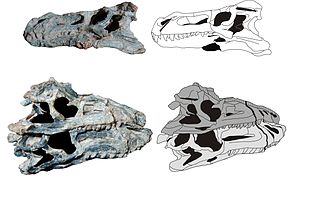
Decuriasuchus is an extinct genus of loricatan from the Middle Triassic period. It is a carnivorous archosaur that lived in what is now southern Brazil, in Paleorrota. It was first named by Marco Aurélio G. França, Jorge Ferigolo and Max C. Langer in 2011 and the type species is Decuriasuchus quartacolonia. The generic name means "unit of ten crocodiles" in Latin and Greek in reference to the ten known specimens and the animal's possible group behavior. The specific name refers to the Quarta Colonia region where the fossils were collected.

Bathyotica is a clade of crurotarsan archosaurs that includes the superorder Crocodylomorpha and its sister taxon Erpetosuchus, a small Triassic suchian. Bathyotica was named in a 2002 phylogenetic study of Erpetosuchus. The genus was found to be closely related to crocodylomorphs, and Bathyotica was erected to encompass both taxa.

Paracrocodylomorpha is a clade of pseudosuchian archosaurs. The clade includes the diverse and unusual group Poposauroidea as well as the generally carnivorous and quadrupedal members of Loricata, including modern crocodylians. Paracrocodylomorpha was named by paleontologist J. Michael Parrish in 1993, although the group is now considered to encompass more reptiles than his original definition intended. The most recent definition of Paracrocodylomorpha, as defined by Sterling Nesbitt in 2011, is "the least inclusive clade containing Poposaurus and Crocodylus niloticus. Most groups of paracrocodylomorphs became extinct at the end of the Triassic period, with the exception of the crocodylomorphs, from which crocodylians such as crocodiles and alligators evolved in the latter part of the Mesozoic.
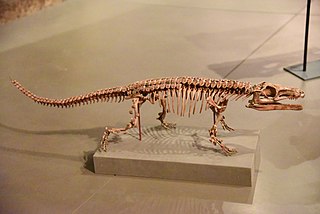
Erpetosuchidae is an extinct family of pseudosuchian archosaurs. Erpetosuchidae was named by D. M. S. Watson in 1917 to include Erpetosuchus. It includes the type species Erpetosuchus granti from the Late Triassic of Scotland, Erpetosuchus sp. from the Late Triassic of eastern United States and Parringtonia gracilis from the middle Middle Triassic of Tanzania; the group might also include Dyoplax arenaceus from the Late Triassic of Germany, Archeopelta arborensis and Pagosvenator candelariensis from Brazil and Tarjadia ruthae from Argentina.
Nundasuchus is an extinct genus of crurotarsan, possibly a suchian archosaur related to Paracrocodylomorpha. Remains of this genus are known from the Middle Triassic Manda beds of southwestern Tanzania. It contains a single species, Nundasuchus songeaensis, known from a single partially complete skeleton, including vertebrae, limb elements, osteoderms, and skull fragments.
Etjosuchus is an extinct genus of "rauisuchian" (loricatan) archosaur from the Triassic of Namibia. It is known from a single species, Etjosuchus recurvidens, which is based on a partial skeleton from the Ladinian or Carnian-age Omingonde Formation.
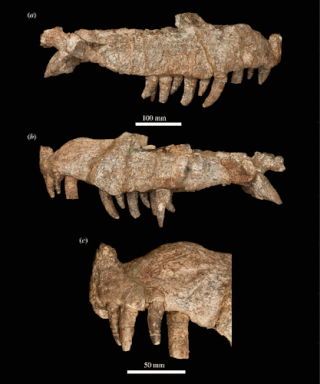
Mambawakale is a genus of large sized basal paracrocodylomorph, possibly a poposauroid, from the Manda Beds of Tanzania. It was informally named Pallisteria before being officially published under its current name almost 60 years after its discovery. It contains a single species, Mambawakale ruhuhu.

